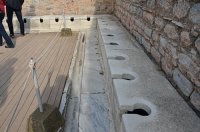Ancient Roman toilets, known as "cloacae" or "latrinae," played a significant role in the daily lives of the Roman people. These sophisticated sanitation systems were far ahead of their time and showcased the engineering prowess and innovation of the Roman civilization. In this article, we will explore the features, design, and cultural significance of ancient Roman toilets.
The Romans recognized the importance of proper sanitation and public health. To address these concerns, they developed a complex network of sewer systems and public toilets that were interconnected with the aqueducts, providing a constant flow of clean water. This remarkable feat allowed for the efficient removal of waste and the prevention of disease outbreaks.
Roman toilets were typically located in public bathhouses, marketplaces, and large communal buildings. They were designed to accommodate multiple users simultaneously, reflecting the communal nature of Roman society. These communal toilets were constructed as long marble or stone benches with holes at regular intervals. Users would sit side by side, often engaging in conversations or socializing while attending to their needs.
To ensure cleanliness and hygiene, Roman toilets were equipped with flowing water. Many of them had a continuous stream of water running beneath the benches, serving both as a flushing mechanism and a way to keep the seating area clean. Some toilets even had a small water channel in front of the benches to provide easy access for cleaning.
Privacy was not a concern in ancient Roman toilets, as the focus was more on efficiency and functionality. However, in more affluent households, private bathrooms known as "latrines" were developed. These private toilets were often located in separate rooms and featured more comfortable seating arrangements. They were commonly constructed with marble seats and even had running water or sponge sticks for personal hygiene.
One notable example of ancient Roman toilets can be found at the ruins of the city of Pompeii. The city's well-preserved public latrines provide valuable insights into Roman sanitation practices. The toilets at Pompeii were arranged in a linear fashion, with a long row of seats built against the walls. They were constructed from stone or marble and had holes covered with wooden or stone slabs for seating.
The waste from Roman toilets would flow into the extensive sewer system that crisscrossed the city. The Romans utilized an advanced underground network of tunnels and channels to transport waste away from populated areas. These sewer systems were often lined with waterproof cement and designed to slope gently, allowing gravity to assist the flow of waste. In some cases, the waste would be flushed out into nearby rivers or streams.
The ancient Roman toilets represented the Romans' advanced understanding of engineering and their commitment to public health. Their sophisticated sanitation systems and innovative design were centuries ahead of their time. These toilets not only provided a solution for waste disposal but also fostered a sense of community and social interaction among the Roman people.
Today, the legacy of ancient Roman toilets can still be seen in modern sanitation systems. Their engineering techniques and principles laid the foundation for the development of sewer systems and flush toilets that are used worldwide. The Romans' emphasis on hygiene and public health has left a lasting impact on how societies approach sanitation, making their toilets an enduring testament to their ingenuity and progressive mindset.
